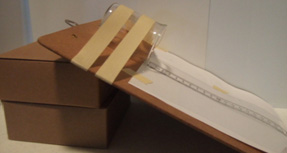
Grades: 5-8
Author: Tess Ewart
Source: Adapted from PALS - http://pals.sri.com/tasks/5-8/Creeping/
Students will observe, measure, and graph a model of slow downslope movement. This task assesses students' abilities to collect, record, and organize data, set up graph axes, plot data points, draw line graphs, apply mathematics, infer based on observational data, predict based on a model, and apply models to other situations.
What should students know as a result of this lesson?
What should the students be able to do as a result of this lesson?
The materials the presenter will need depend on the "creeping material" chosen. See Advance Preparation.
For Glop, the teacher will need:
For Oobleck, the teacher will need:
Or you can use commercially bought Slime for this experiment.
At each station, students should have the following:
Engagement
Show an image of a mountain range or a fault line. One that can be found at the following web sites:
Ask the students: "How fast are the mountains moving? How fast are Earth's tectonic plates moving? (most can be measured in centimeters per year) How do you know? How do scientists know?" (accept all answers - scientists can use sensors to take detailed measurements)
Tell the students that, "Scientists have to keep accurate data over time. They usually represent this data in graphs to convey their ideas to other people. Why is it important for students to be able to read graphs effectively?" (Being able to read graphs effectively can improve students' scientific literacy) The best way to work on this skill is to have students construct graphs of their own.
Discuss with the students why it is important to have experiments repeated several times. (Repeating experiments several times ensures the validity of the results and conclusions)
Tell the students that "scientists also represent their ideas using models." Students will now use a model to represent a type of slow mass wasting called creep.
Assessment: Student discussion
Exploration

Assessment: Completed student answer sheets
Explanation
Ask the students, "What type of graph would be best to use for the data you just created? Why?" (A line graph would be best because it shows movement over time of the material.)
Have the students create a graph for their data giving little guidance. When finished, have the students share the graphs they created. Ask the students, "What is similar about the graphs? What is different?" (accept all answers) "What makes a good graph?" (Every graph should contain the following elements: a title, labeled axes with the appropriate units in parentheses, axes that start at the origin (0,0), numbered axes in regular intervals (but it does not have to go by ones and the two axes do not have to increase by the same interval), and provide a key if you have more than one line.) The Dalton School: Graphing Guidelines - http://intranet.dalton.org/departments/Science/Biology1/graph_guidelines.html
Tell the students, "Sometimes, scientists use models to convey their ideas to people. These models have their limitations and do not totally represent what is occurring in real life. For example, a candy bar can be used to illustrate the movement of tectonic plates on Earth's asthenosphere. The movement of the 'tectonic plates' in the candy bar is made by the person holding the bar while the motion of the tectonic plates in Earth is due to the convection currents within the asthenosphere." The limitations of models should be discussed with students.
Assessment: Completed graphs and discussion
Elaboration
Ask the students, "What do the graphs show about creep? (As the angle of repose (height of the board) increases, the material should flow faster.) What does this mean for hill sides? (The steeper the hill side, the more likely material will flow, the faster it will flow.) What would be some real life situations where creep would be an issue?" (accept all answers)
Make sure you stress to students that while each group is doing one trial at different elevations, by having the whole class do the same three elevations, this would constitute repeated trials.
Have students predict what would happen to the graph if the viscosity (thickness) of the material changes. Have students predict what would happen to toothpicks that are placed in a straight line across the material. Students should give their reasons behind their ideas. If enough time, have students explore their ideas.
Assessment: Application of model to real life situations, graph predictions
1. Make "Creeping Material"
2. Exploration materials setup for each lab station:
Use masking tape to keep the beaker steady on the clipboard by taping across the beaker onto the clipboard. The lip of the beaker should be on the tape at the 0 cm mark of the transparency.
NGSS Standards:
Common Core Standards:
National Standards:
Ohio Standards:
Mass wasting is the name for all of the Earth processes by which gravity pulls materials down. Some of the processes, like landslides and avalanches, are rapid, while others, like soil creeping, occur so slowly that observations are difficult to obtain.
Graphing can be applied to global warming, glacial movement, plate tectonics
Have the students "solve" the problems illustrated by the graphs from the following web sites:
Grouping Suggestions: Students should be ready to work as soon as the period begins. The materials should be set out at each lab station, if possible. A central supply area, if needed, should be easily accessible. All supplies should be clearly labeled.
Issues to consider are the following: seating so everyone can see the display and graphs, make sure every person participates in discussions and exploration, and grouping with diversity in mind.
Pacing/Suggested Time: One hour